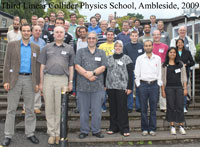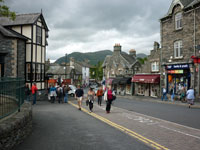 |
 |
|||||||||||||
|
|||||||||||||
|
|||||||||||||
|
A lively debate across age groups and cultures marked the Third Linear Collider Physics School, held in Ambleside, UK, in August. For the first time, designated discussion periods were set aside for up–and–coming scientists to share their work and opinions on the future of accelerator–based particle physics with international experts. The week–long event held at the Ambleside campus of the University of Cumbria in England expanded on the technical and physics issues of past schools with three discussion topics: the "big questions" in the field: electroweak, Higgs physics and accelerator physics; quantum chromodynamics, exotics and cosmology. The school was organised by Andre Sopczak of Lancaster University together with his colleagues Chris Bowdery and Jonathan Gratus. Students also for the first time had a chance to report on their research and obtain expert feedback. “To me, it has been a very interesting school from which I learned a lot about the future facilities, the new ideas to be developed and to be discussed and the path our field will follow in the near future,” said Lorenzo Basso from the NExT Institute, University of Southampton and Rutherford Appleton Lab, in an evaluation of the school. “It has been a good place to exchange opinions and discuss ideas and to get updates regarding the concrete projects by my experimental colleagues. I also appreciated, especially, the time devoted to discussion, in which students like me could express opinions.” The school, last held in 2006, helps prepare PhD students and postdoctoral researchers to work on the proposed linear collider. Although the circular Large Hadron Collider at CERN in Switzerland will undertake a first survey of the TeV energy scale (a trillion times the energy provided to an electron by a 1 Volt battery), a linear collider is considered to be best positioned to make detailed measurements of any new particles found by the LHC, as well as the already discovered top quark and the weak force's Z boson. A programme and organising committee and an international advisory committee selected twelve lecturers from across the globe to give 21 talks to 50 participants from 15 countries with interests in accelerators, detectors, phenomenology theory and data analysis. Thus the school gave students a chance to learn about all aspects of a future linear collider and deepen their research interests. Physics sessions delved into an introduction to the Standard Model (SM) of electroweak interactions and QCD, top quark physics, exotic particles, supersymmetry, the Higgs mechanism and Higgs bosons in the SM and the Minimal Supersymmetric Standard Model (MSSM). Accelerator sessions introduced basic concepts such as synchrotrons, transverse focusing, phase stability and beam emittance. Later discussions focused on linacs and the designs of the ILC and the Compact Linear Collider Study (CLIC). Experimental sessions highlighted Higgs searches at today's hadron colliders and the outlook for linear colliders, along with a survey of detector technologies for the ILC and CLIC. “Lectures were very useful for me,” wrote Vasili Andreyeu, from the State University in Belarus. “I really learnt a lot. I think they were interesting both for experimentalists and theorists. They covered a lot of different topics on collider physics, and, I think, everybody has found something helpful for his (her) research.” You can view slides of the lectures on the school's Web site. Write–ups of the lectures will be published electronically by the Proceedings of Science (PoS) as the "Third Linear Collider Physics School 2009 (LCPS2009)". -- Andre Sopczak, Lancaster University
You can also check the student's page on Facebook
and view more photos here.
|
|||||||||||||
| © International Linear Collider |

